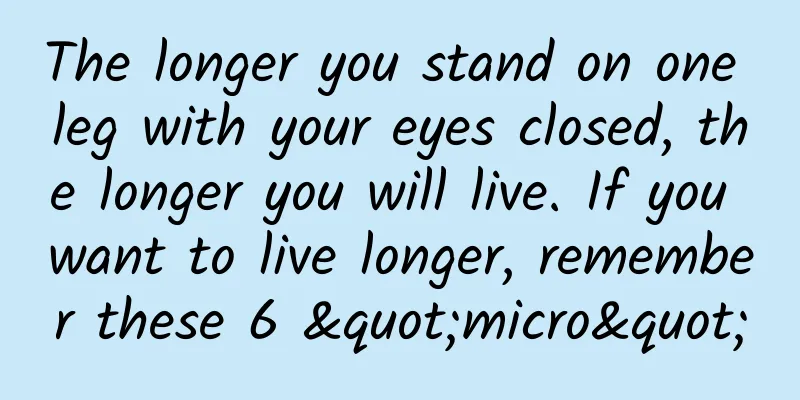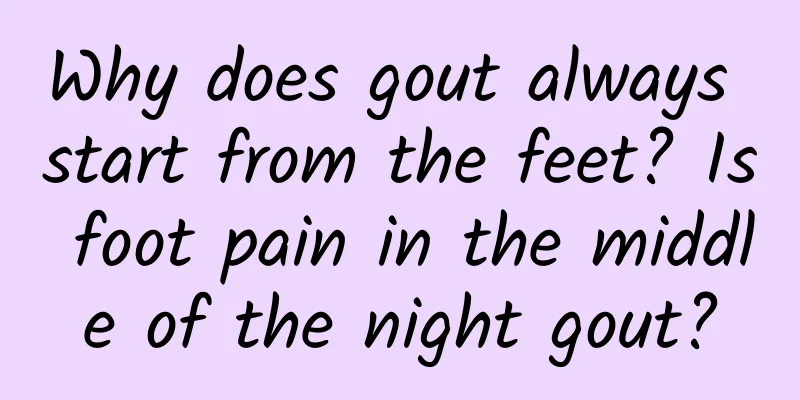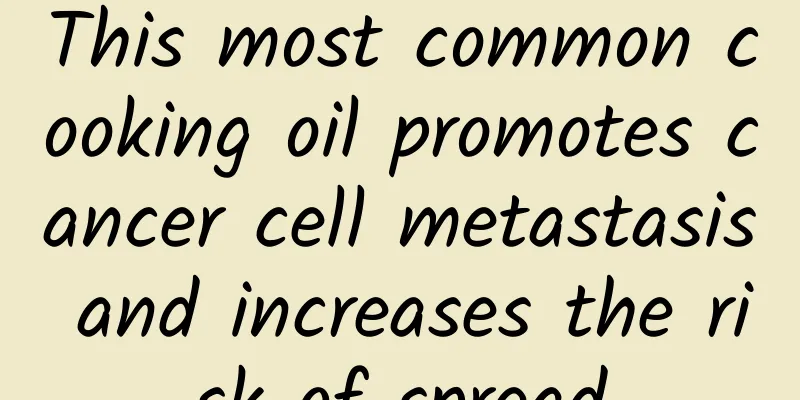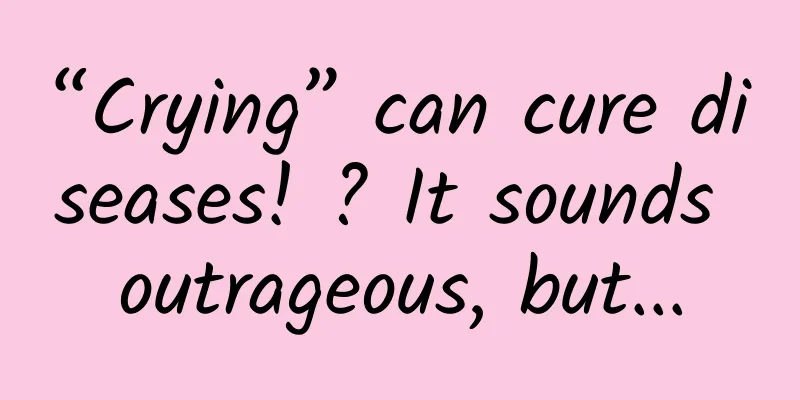The longer you stand on one leg with your eyes closed, the longer you will live. If you want to live longer, remember these 6 "micro"

|
Editor's note: With the improvement of living standards, health has become the topic we are most concerned about. What is healthy food? How to prevent physical diseases in life? These have become the focus of everyone's attention. People's Health Network has launched the "Jintai Health Garden" column to take stock of the most healthy lifestyle for you and take you into the health garden. The longer you stand on one leg with your eyes closed, the longer you will live. According to a study by the British Daily Mail, standing on one leg with eyes closed can, to a certain extent, indicate longevity. If you can hold on for more than 10 seconds, it means that all your body systems are in a relatively balanced state and your health is relatively good. Otherwise, it means that your reaction muscle strength and balance are weak and you age quickly. The single-legged eyes-closed standing test measures the time a person can maintain their center of gravity on a single-leg support surface without any visual reference, relying only on the balance receptors of the vestibular organs of the brain and the coordinated movement of the muscles throughout the body. This test reflects the strength of the balance ability. From the age of 35, the body's balance begins to decline, so it is easy to fall when you are old, but if you can persist in training your balance, you can stay younger. Balance training generally uses unconventional exercises to stimulate the body to make a balance response. Standing on one leg with eyes closed is a very effective training. Don't rush for results when practicing, you can close your eyes after training for a period of time. The specific steps are: put your hands on your waist, close your eyes, stand on one leg, bend the other leg, lift your foot off the ground, and make your calf close to the knee of the standing leg. When you first practice, you need to change the other leg after about 10 seconds. If you practice every day, you can keep it up for a longer time. It should be noted that the elderly have weaker bone and muscle strength, so they should be supported by something during training to avoid falling. In addition to standing on one leg with eyes closed, you can also try walking in a straight line with a book on your head, walking on a balance beam or a plum blossom pole. If you want to live longer, remember the six "micro" aspects of health Scientists have proposed that being slightly overweight (10% above standard weight), slightly cool (about 20 degrees), slightly hungry, slightly sweaty, slightly silly and smiling are conducive to health and longevity. Among them, a reasonable diet is an important part of health management. It is necessary to pay attention to nutrition and prevent overnutrition. At the same time, we should also pay attention to how to clean up free radicals in the body. The main measures are: mastering dietary balance, total amount control, and eating according to needs. Do not eat or binge according to your own hobbies. A balanced diet is a diet made by scientifically matching a variety of foods. For meat and vegetables, mainly vegetables, keep low fat; for sweet and salty, mainly light, keep low sodium; for coarse and fine, mainly coarse, preferably whole bran; for color, mainly green, one-third. Maintain an appropriate ratio of the six major nutrients: protein 15%, fat 20%, carbohydrate 65%. At the same time, it is also necessary to consider the proper matching of power element, volume element, and moisturizing element. Specifically, you need to consume 4 to 6 taels of staple food every day, including rice, wheat, miscellaneous grains, miscellaneous beans and potatoes, 1 boiled egg, 300 ml of dairy products, 1 tael of nuts, 1 tael of lean meat (fish, shrimp and other meats can be eaten alternately). Pay attention to supplementing fresh vegetables such as bamboo shoots, tomatoes, spinach, carrots, eggplant, pumpkin, celery, lotus root, onion and high-potassium and low-sugar fruits such as kiwi, dragon fruit, cucumber, red grapes, apples, bananas, citrus, etc. The proportions of various foods should be coordinated. If a certain nutrient is not supplemented enough, it will affect the body's repair process, making the repair impossible; if it is supplemented excessively, it will lead to the accumulation of active acid (active oxygen free radical) garbage in the internal environment. For example, if protein is taken in too much, its metabolites nitrogen, purine, and uric acid will cause gout and even damage the kidneys; excessive fat intake will produce ketone bodies, triglycerides and other vascular garbage; sugar or sweet fruit intake exceeds the pancreas' sugar tolerance, making it easy to get diabetes; excessive total food intake exceeds the stomach's tolerance, causing indigestion; eat less meals that have been left over from other meals or overnight, do not eat expired and spoiled food, and pay attention to regular eating, regular and quantitative, and chew slowly. In short, eat when hungry and drink when thirsty, and drink to seven parts of the amount. It is better to be short than full, and not to eat when not hungry. As the saying goes, one meal hurts, ten meals make you sick. Overeating will significantly increase the fibroblast growth factor in the brain. Long-term overeating will inevitably lead to cerebral arteriosclerosis, intellectual impairment, and the induction of "three highs". People have eight "health nests" 1. Press the eye sockets to calm the nerves and relieve headaches. There are many acupoints in the eye sockets, such as Qingming, Zanzhu, Sibai, Chengqi, Sizhukong, etc. Massage can reduce intraocular pressure, relieve eye fatigue, improve eye function, and significantly improve red eyes, blurred vision, and unclear vision caused by myopia, presbyopia, and excessive use of eyes. Massaging these acupoints can also calm the nerves, relieve headaches, and delay aging of the skin around the eyes and prevent wrinkles. Close your eyes lightly, and use the index and middle fingertips to slowly rotate the eyelids clockwise and counterclockwise for 5 to 10 times, respectively. You can also press lightly on the corresponding acupoints for about 1 minute, which will have a better effect in calming the nerves and relieving pain. 2. Press the neck fossa to relieve throat discomfort. The neck fossa is located below the Adam's apple and above the sternum. This is where the Tiantu point is located, which is a Ren meridian point. It is located four inches below the throat and in the middle of the sternal fossa. It has the functions of widening the diaphragm and stomach, lowering adverse qi and regulating qi. Stimulating the neck fossa can improve symptoms such as throat discomfort, coughing and wheezing, nausea and hiccups. You can press the neck fossa with your thumb or index finger, and apply force slowly and evenly inward and downward, or press and rub in circles while swallowing for about one minute, until you feel a local soreness and stuffiness. 3. Rub the armpits, relax the chest and calm the mind. The armpits, commonly known as "armpits", have the Jiquan point at the top where the artery pulsates. Acupuncture or massage of this point has the effect of relaxing the chest and calming the mind, and is beneficial for preventing and treating circulatory and nervous system diseases, such as coronary heart disease, angina pectoris, and intercostal neuralgia. Put four fingers together under the armpits, massage clockwise and counterclockwise, and alternate every 10 circles, for a total of 100 to 200 times; you can also press, press the right armpit with your left hand, press the left armpit with your right hand, and press the Jiquan point with the tip of your thumb, and press repeatedly until you feel sore, numb, and hot, which usually takes 3 to 5 minutes. 4. Pat the elbow pit to clear away heat and dredge the meridians. The elbow pit is located in front of the elbow joint. It is the passage of the hand Shaoyin heart meridian, the hand Jueyin pericardium meridian, and the hand Taiyin lung meridian. There are acupoints such as Quchi, Quze, and Chize. When there are too many metabolites in the blood, the blood viscosity increases, and the meridian qi and blood are easily retained in the elbow joint. The meridians are blocked, causing hyperactivity of heart fire and lung heat, and symptoms such as sore throat, cough with yellow sputum, irritability and insomnia will appear. Massaging the acupoints in the elbow pit can dredge the meridian qi and blood, clear away heat and dampness, and calm the mind and relieve sore throat. Put four fingers together, and pat the left and right sides several times from light to heavy, and then from heavy to light. Pay attention to the rhythm when patting. You can also gently massage the local acupoints to feel a slight heat and soreness in the elbow. 5. Regulate Qi and blood by stroking the dimples on the waist. The dimples on the waist are the concave areas on the left and right sides of the lumbar spine, with Jiaji points and Beishu points distributed on both sides. Jiaji points belong to the extra meridian points, and Beishu points belong to the points of the foot-sun bladder meridian. They are the places where the Qi of the internal organs is infused, and have been highly praised by health massage in all dynasties. Regular massage of the dimples on the waist can coordinate the Qi and blood of the meridians and harmonize the internal organs. It is best to massage the dimples on the waist from top to bottom along the spine. 6. Rub the popliteal fossa to relieve back pain. The popliteal fossa is the depression behind the knees on both sides. It is the area where the liver meridian, kidney meridian, and bladder meridian of the twelve meridians run. The acupuncture point in the middle of the popliteal fossa is Weizhong. In traditional Chinese medicine, acupuncture and massage emphasize "seeking Weizhong for back pain", which means that Weizhong is a key acupuncture point for the treatment of back pain and lower limb joint flexion and extension. There are also Weiyang, Yingu, Fuxi and other acupuncture points on both sides of Weizhong acupuncture point, which are all acupuncture points for the treatment of back pain. Rub your palms to warm them up, rub the popliteal fossa on both sides back and forth, and press the acupuncture points intermittently. It is also appropriate to have local fever and soreness. It can not only relieve pain in the back and lower limb joints and flexion and extension, but also strengthen the body's protective function and enhance immunity. 7. Push and rub the foot hollows to boost your energy. The Yellow Emperor's Classic of Internal Medicine says: "The kidneys come from the Yongquan, which is the center of the foot." The Yongquan acupoint, an important acupoint for human health care, is hidden in the foot hollow. It is located at the bottom of the foot, in the concave part of the front of the foot when the foot is curled up. This acupoint is the first acupoint of the kidney meridian and plays an important role in human health preservation, disease prevention, treatment, and health care. Pushing, rubbing, and tapping the Yongquan acupoint with massage techniques can boost people's energy, strengthen their physique, and enhance their ability to prevent diseases. In addition to the above 7 health nests, the human body has another key nest - the umbilical nest, located in the depression in the center of the abdomen, where the Shenque acupoint is located. "The Origin of Medicine" says: "When a person is born, he is born at the umbilical cord and the gate of life, so it is the beginning of the twelve meridians and the formation of the five internal organs and six bowels." Therefore, the umbilical cord has a close physiological and pathological connection with the twelve meridians, five internal organs, limbs, bones, skin, fur, bones and flesh of the human body. Although it has a health-care effect, this place is connected with all meridians and meridians, and is connected to the five internal organs, brain and uterus. It is recommended to perform health-care operations under the guidance of a doctor. It should be noted that the massage should not be too strong. People with long-term illness and weak body should not use too much patting stimulation. People with skin damage or acute inflammation or malignant tumors in the abdomen should use it with caution or avoid it. It can also be combined with local application of medicine, such as warm compress of chrysanthemum decoction on the eye socket to relieve eye discomfort. Health preservation grasps four important periods Half an hour after a meal: brush your teeth. I would like to remind you that brushing your teeth immediately after a meal is harmful to your dental health. Because there is a layer of enamel on the surface of the crown, the enamel becomes soft just after a meal, especially after eating acidic foods. Brushing your teeth immediately at this time will damage it. Over time, the enamel of the teeth gradually decreases, making it easy to suffer from dentin hypersensitivity and feel soreness when eating. Therefore, it is recommended that the elderly rinse their mouths with clean water after a meal and brush their teeth half an hour later to prevent tooth decay. 1 hour after a meal: Walk. Taking a walk after a meal can promote gastrointestinal motility, improve the respiratory system, and promote blood circulation, but you should rest for about an hour before taking a walk. Do a simple warm-up before taking a walk, such as rubbing your hands and feet, raising your arms, stretching your muscles, etc. The walking posture is also very important. Keep your head up and your chest up to avoid compressing your chest and affecting your heart function. Don't take big steps or walk too fast or too fast. Make sure your heels touch the ground first, and swing your arms back and forth vigorously with the rhythm of your walk. Don't walk on rugged roads or narrow paths, and don't walk with your hands behind your back or backwards. It's best not to walk for more than 1 hour. 9pm: Soak your feet. Soaking your feet at night will increase your body heat and dilate your blood vessels, which is good for blood circulation. Elderly people should remember not to use plastic buckets to soak their feet. It is best to choose a deeper wooden bucket, which is easier to keep warm. The water temperature should not be too hot or too cold, generally 40 to 45 degrees Celsius is best. The water should completely submerge the instep, and the time should not be too long, because the elderly are prone to sweating and panic after soaking for too long, 20 to 25 minutes is enough. After soaking your feet, it will have a better health effect with foot massage. 90 minutes before bedtime: take a bath. This way, your body temperature will drop to the most suitable temperature for sleeping before going to bed. It is recommended to drink about 150 ml of warm water before taking a bath, which can prevent the blood viscosity of the elderly from increasing. The bathing time should be controlled within 15 minutes, otherwise it may cause capillary dilation, brain tissue hypoxia and ischemia, angina pectoris, etc. The bathing water temperature should be around 40 degrees Celsius. (People's Health Comprehensive from Life Times) |
<<: How to stabilize high blood pressure in autumn and winter? Follow two principles
Recommend
Signs of a stroke in a woman
Stroke refers to a brain disease in the human bod...
How long will influenza A and B continue to spread? Children with four types of symptoms should be alert to the possibility of pneumonia:
Yesterday, the National Health Commission held a ...
The most weight-loss-enhancing fruit in autumn, I won’t let you not know!
Autumn is here. There is a kind of fruit with gol...
The woman's left eyelid keeps twitching
I believe many people have heard a line of lyrics...
What should women pay attention to when their left hand is numb?
The ten fingers are connected to the heart, and t...
What is the reason for brown menstrual blood and how to regulate it?
If a female friend finds that her menstrual blood...
Can I add sugar to scented tea? How to make scented tea the best?
Scented tea is a common type of tea in life. It i...
What to do if you have severe toothache during pregnancy
Pregnancy is a special period for women, during w...
Causes of abdominal pain caused by non-menstrual bleeding
Symptoms of non-menstrual bleeding and abdominal ...
DCCI: In 2012, Weibo users accounted for 88.8% of adult netizens, and the scale has stabilized
Weibo users account for 88.81% of Chinese netizen...
Girls often have diarrhea
Girls often suffer from diarrhea because of cold ...
Can I drink yogurt during menstruation? What should I pay attention to?
Yogurt has many benefits to the human body. The l...
What are mammary alveoli?
During the development of women, the mammary glan...
What kind of exercise is good for the uterus and ovaries?
Protecting the ovaries is something that women ta...
What medicine should women take for itchy urethra?
The female urethra and vagina are very close, and...









